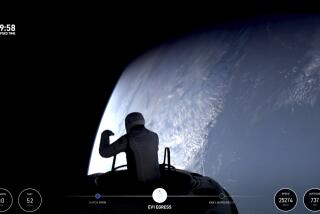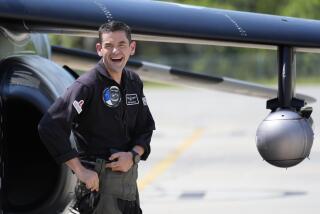Space Age Pioneer Glenn Returns to Orbit
CAPE CANAVERAL, Fla. — As the shuttle Discovery made its fiery ascent through a brilliant blue sky, astronaut John Glenn rocketed back into space--and deeper into American history--Thursday, at 77 the oldest person ever to orbit the Earth.
“At this historic moment, let the wings of Discovery lift us on to the future,” launch control said as the 4.5-million-pound spacecraft rose from clouds of white smoke that spiraled over the Kennedy Space Center.
In a windowless rear seat, Glenn--the Democratic senator from Ohio and a space pioneer--was just one of seven astronauts aboard Discovery (and a lowly payload specialist 2 at that) as the gleaming orbiter swung eastward out over the Atlantic Ocean minutes after lifting off to start its nine-day mission.
But as one of the original seven Mercury astronauts and the first American to orbit the globe 36 years ago, Glenn has taken a back seat to no one in his ability to focus attention on a U.S. space program in which shuttle launches have become routine.
“It’s a great day for America, a great day for our senior citizens,” said President Clinton, who along with First Lady Hillary Rodham Clinton joined hundreds of thousands of spectators on hand to watch Discovery make a perfect, ground-rattling liftoff from launch pad 39-B.
The launch was broadcast live by every major U.S. television network, and watched by viewers around the world.
Among other Mercury alumni here for Glenn’s return to space were Walter Schirra, Gordon Cooper and Scott Carpenter, who famously uttered the benediction “Godspeed, John Glenn,” the last time his fellow astronaut headed for space.
Carpenter, working as an NBC-TV color analyst on Thursday, repeated the same line on liftoff. He had rehearsed saying, “Godspeed, Discovery,” but forgot in the excitement of the moment.
Glenn finally heard his friend’s message 9 1/2 hours after liftoff, when mission control replayed it for the crew.
“I really appreciate that,” Glenn said, asking NASA officials on the ground to pass on his thanks to Carpenter. “That meant a lot to me way back many years ago when Scott came on with that back in ‘62, and it still means a great deal today.”
Two Delays Before Launch
Although the launch went flawlessly, there were two delays. One was caused by what NASA called a “minor technical issue” involving an alarm that was set off by normally rising cabin pressure. The countdown was interrupted again when a private plane entered restricted airspace nearby.
Discovery finally cleared the launch pad at 11:20 a.m. PST, about 20 minutes behind schedule.
At a post-launch briefing, NASA officials said that a door covering a drag chute used in landing may have been jarred loose during liftoff and may have hit one of the main engines. The problem was considered minor, however, and unlikely to affect the mission.
Sharing weightlessness with Glenn aboard Discovery--if not sharing the attention--is a crew led by veteran astronaut Curtis L. Brown, the shuttle commander, who has flown four previous missions. Also on board are pilot Steven W. Lindsey, mission specialists Stephen K. Robinson and Scott E. Parazynski, along with Spanish engineer Pedro Duque and Japanese physician Chiaki Mukai.
Clinton was the first president to attend a launch since Richard Nixon waved goodbye to the Apollo 11 moon mission in 1969.
Also in the VIP gallery were dozens of legislators, former astronauts and even movie stars. “Titanic” star Leonardo DiCaprio, in town to witness the launch, created a stir among those too young to remember Glenn’s historic return to space.
But even the celebrity of Hollywood stars was overshadowed here by the hoopla over Glenn. An estimated 250,000 spectators lined causeways, parks and beachfronts to watch the spectacular blastoff, and tourism officials said visitors would pump about $20 million into the Space Coast economy.
Launch fans arrived early at prime viewing spots that were not already roped off or rented out, and vendors selling Glenn souvenirs--everything from T-shirts to action figures--worked the crowds.
“It was the coolest thing I ever saw,” 8-year-old Sam Prince told his mother as the family from St. Louis watched the launch from a spot along the Indian River.
Inside the press center, more than 3,500 journalists strung miles of wire and cable, took thousands of photographs and pounded out millions of words in trying to capture an event in which the science and risk of spaceflight seemed overwhelmed by the sentiment of Glenn’s return.
Before the launch, many former and current astronauts strolled through the press area, making themselves available for comment and reflection. Some--Schirra, Carpenter and Cooper, for example--were recognizable because they, too, are space pioneers, and were working Thursday as television network commentators.
But among those who could be identified as astronauts only by their blue flight suits and name tags was Kay Hire, a 39-year-old engineer who last spring spent nearly 16 days in orbit aboard the shuttle Columbia on a mission that received relatively little notice.
“The baby boomers remember his first launch,” said Hire, who was 2 years old when Glenn first orbited Earth in 1962, “and it’s great for them. But the best part is that this is turning a whole new generation of kids on to the space program.”
Glenn’s chief task aboard Discovery is to serve as a guinea pig for geriatric studies involving the sleep cycle, immune system and changes in muscle mass. While NASA has defended the scientific merit of the experiments, critics have scoffed.
Glenn, who is retiring from a 24-year career in the Senate, lobbied hard for another spaceflight. He said he finally persuaded NASA to launch him again because he will help collect valuable data on the effects of microgravity on aging.
“If you eliminate the science benefit, there’s no reason [for me] to go except I want to go again,” Glenn told reporters in an interview last week in Houston. “But that’s not justification for going. A lot of people want to go.”
In an interview with Walter Cronkite on CNN, Clinton denied that Glenn was granted a spot on the mission as payback for his political loyalty. “I think the American people should know that the decision to send him was made strictly by the book,” Clinton said. “I had no role in it.
“Like all Americans, I’m thrilled he’s going up here,” he added.
Astronauts Offered Hearty Breakfast
The astronauts were awakened at 8:30 Thursday morning, offered a breakfast that included filet mignon, grits and yogurt, and then had a chance to telephone their loved ones before donning bright orange spacesuits. Glenn said goodbye to his wife of 55 years, Annie.
Although Glenn could not see the retreating Earth during the roaring 8 1/2-minute climb into orbit--72 miles above the ground--he assured reporters Wednesday that he would enjoy the view later. “Don’t worry, I’ll get window time,” Glenn said.
He had endured 10 scrubbed launch attempts before finally getting off the ground on Feb. 20, 1962. Sardined into the tiny Friendship 7 capsule, Glenn made three orbits of Earth before splashing down in the ocean.
This time he and the Discovery crew are scheduled to make 144 laps of Earth before gliding back to a Kennedy Space Center runway Nov. 7.
Video clips of Thursday’s shuttle launch and a video retrospective of John Glenn’s career as an astronaut are on The Times’ Web site. Go to: http://netblogpro.com/glenn
More to Read
Sign up for Essential California
The most important California stories and recommendations in your inbox every morning.
You may occasionally receive promotional content from the Los Angeles Times.










